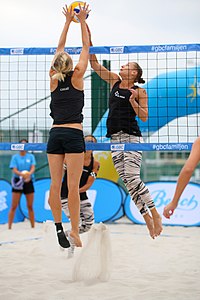
Back Strandvlugbal Afrikaans كرة طائرة شاطئية Arabic بيتش ڤوليبول ARZ Voleibol de sablera AST Çimərlik voleybolu Azerbaijani Пляжны валейбол Byelorussian Пляжны валейбол BE-X-OLD Bola tepok panté BEW Плажен волейбол Bulgarian বীচ ভলিবল Bengali/Bangla
 The blocker (left) attempts to stop the opposing team's attack over the net. | |
| Highest governing body | FIVB |
|---|---|
| First played | 1915, Waikiki, Hawaii, United States |
| Characteristics | |
| Contact | No |
| Team members | 2 or more per side |
| Mixed-sex | Single and mixed |
| Type | Outdoor, team sport, net sport |
| Equipment | Beach volleyball |
| Glossary | Volleyball jargon |
| Presence | |
| Country or region | Worldwide |
| Olympic | Since 1996 |
| World Games | 1993 |
Beach volleyball is a team sport played by two teams of two to four players each on a sand court divided by a net. Similar to indoor volleyball, the objective of the game is to send the ball over the net and to ground it on the opponent's side of the court. Each team also works in unison to prevent the opposing team from grounding the ball on their side of the court.[1]
Teams are allowed up to three touches to return the ball across the net, and individual players may not touch the ball twice consecutively except after a touch off an attempted block. Making a block touch leaves only two more touches before the ball must be hit over. The ball is put in play with a serve—a hit by the server from behind the rear court boundary over the net to the opponents. The receiving team typically uses their three touches to pass the ball, set it up for an attack, and then attack the ball by sending it back over the net. Meanwhile, the team on defense typically has a blocker at the net and a defender to cover the ground. The rally continues until the ball is grounded on the playing court, goes "out", or a fault is made in the attempt to return the ball.[2][3] The team that wins the rally scores a point and serves to start the following rally. The players serve in the same sequence throughout the match, changing server each time a rally is won by the receiving team.
Beach volleyball most likely originated in 1915 on Waikiki Beach in Hawaii, while the modern two-player game originated in Santa Monica, California, where the first volleyball courts were put up on the beach. It has been an Olympic sport since the 1996 Summer Olympics. The Fédération Internationale de Volleyball (FIVB) is the international governing body for the sport, and organizes the FIVB Beach Volleyball World Championships and the FIVB Beach Volleyball World Tour.[4][5]
- ^ "Beach Volleyball History".
- ^ "Rules" (PDF). fivb.org. Archived (PDF) from the original on 20 September 2009. Retrieved 22 March 2020.
- ^ "Rules" (PDF). fivb.org. Archived (PDF) from the original on 4 October 2013. Retrieved 22 March 2020.
- ^ "FIVB Beach Volleyball World Tour Format Overview 2017-2020" (PDF). Fédération Internationale de Volleyball. Archived (PDF) from the original on 20 March 2018. Retrieved 20 March 2018.
- ^ "History - Beach Volleyball".